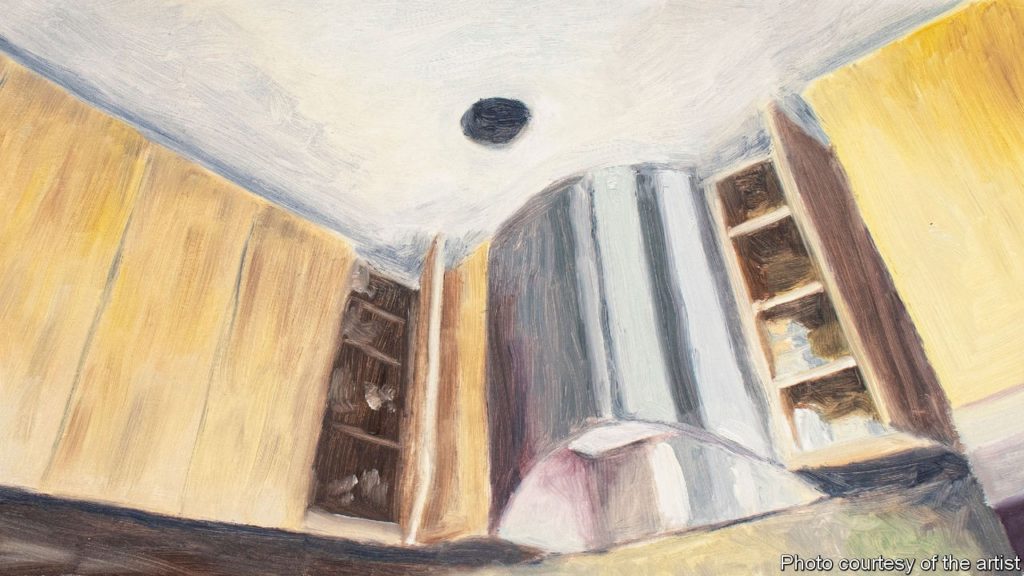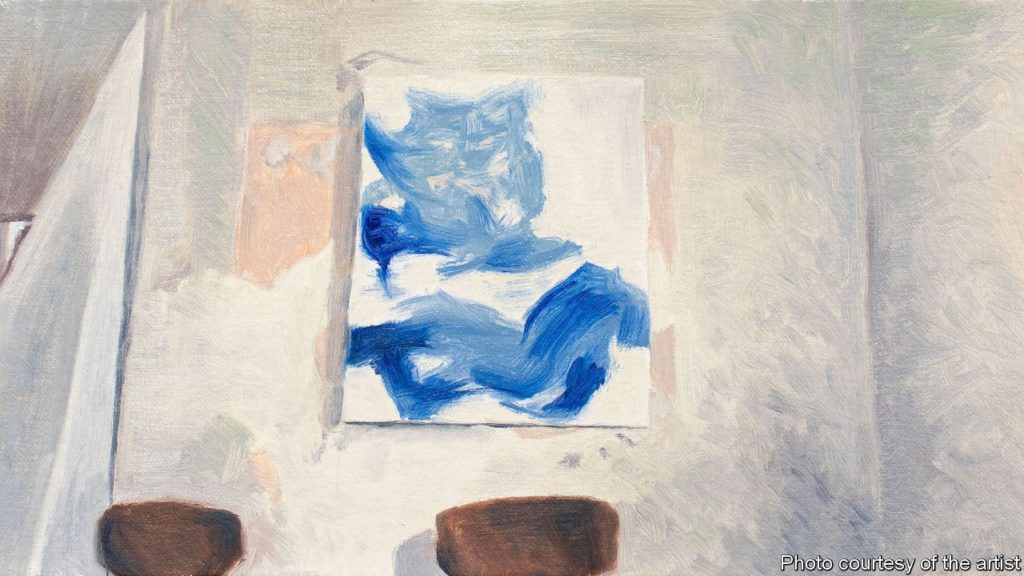The way we live now
“The Zoom Paintings” are dispatches from a strange year
In lockdown Michael Mandiberg started capturing the offices, bedrooms and kitchens of others while on video calls
by S.H. Dec 3rd 2020

IT IS THE corner of someone’s empty kitchen. Cabinets have been left open haphazardly; an oven hood and a slice of the ceiling is visible. The scene has a slightly dizzying quality, as when a laptop camera is tilted upwards, but this is an oil painting. Entitled “Uncle Bob 85th Birthday via Zoom, 3:00-4:00 PM, August 16, 2020”, the artwork is part of a new series by Michael Mandiberg.
Mandiberg (who prefers to adopt gender-neutral pronouns) often explores the digital world in their work. They once programmed a computer and iPhone to take screenshots and images every 15 minutes for a year to create a disturbing video about data and the phenomenon of self-tracking. Between 2009 and 2015 they wrote software that transformed Wikipedia’s English-language database into printable volumes. Each book—of which there were 7,473, though not all were printed—was 700 pages long.
“The Zoom Paintings” began early in lockdown. Like many others, Mandiberg, who is immunosuppressed, had to endure a marathon of daily Zoom calls with colleagues and friends. Exhausted and anxious from the experience of screens, self-isolation and the wailing sirens in New York, they began to paint while on the calls as a way to relax. They would select a participant’s room and paint a section of it on a six-by-11-inch canvas. The aim was to finish the artwork during the meeting, though that was not always possible. Only sometimes did they tell the subject that their room was being depicted.
The resulting series is like a set of strange postcards representing the view from this year; the grids on computer screens have been portals to other places during the pandemic. There is a white-walled room with what looks like the top of a cot, barely visible in the corner, and perhaps the sleeve of a jacket on a hook. There is, in one case, greenery and sky. There is a room in which light filters through a thin blue curtain. This last painting, in particular, calls to mind the work of Edward Hopper, an American artist who often painted windows and the corners of spare-looking rooms. In his painting “Rooms by the Sea” (1951), sunlight streams in through a door that opens onto the ocean. Hopper’s work, like “The Zoom Paintings”, often alludes to isolation.

People are more conspicuously absent from Mandiberg’s work, however: no subjects ever appear in these paintings. The series reflects less the loneliness of specific individuals and more a general feeling of emptiness and absence. Mandiberg’s paintings are also much softer than Hopper’s, with a slight fuzziness that mimics low-fi cameras and unstable WiFi connections. Even still, small details jump out: a placard that reads “NO CUTS, NO LAYOFFS, INVEST IN CUNY NOW” or the painted rims of blue-and-white plates. But often things are obscured: the viewer can’t quite make out what’s in the kitchen cabinet, or whether it’s a mirror or a poster hanging on the wall.
Fittingly, the paintings have only been displayed virtually. For two weeks in November, Denny Dimin Gallery mounted an exhibition of the art on Zoom, featuring one work per day that visitors could visit on screen. As part of its Net Works series, House of Electronic Arts Basel made the paintings downloadable for use as Zoom backgrounds for a period of time. Mandiberg has posted images of the paintings on Instagram, too. But there has been no in-person gallery experience yet.
There would be something cathartic about seeing the hard copies of these paintings, thus experiencing virtual life translated into physical form. But there is also something poignant about the way this project captures movement across spheres and media: physical rooms transmuted to Zoom screens, interpreted on a painted canvas, and then photographed and transferred back to screens. This kind of translation and simulation, the constant back-and-forth between physical and virtual realms, has been a dominant feature of this strange and isolating year.
